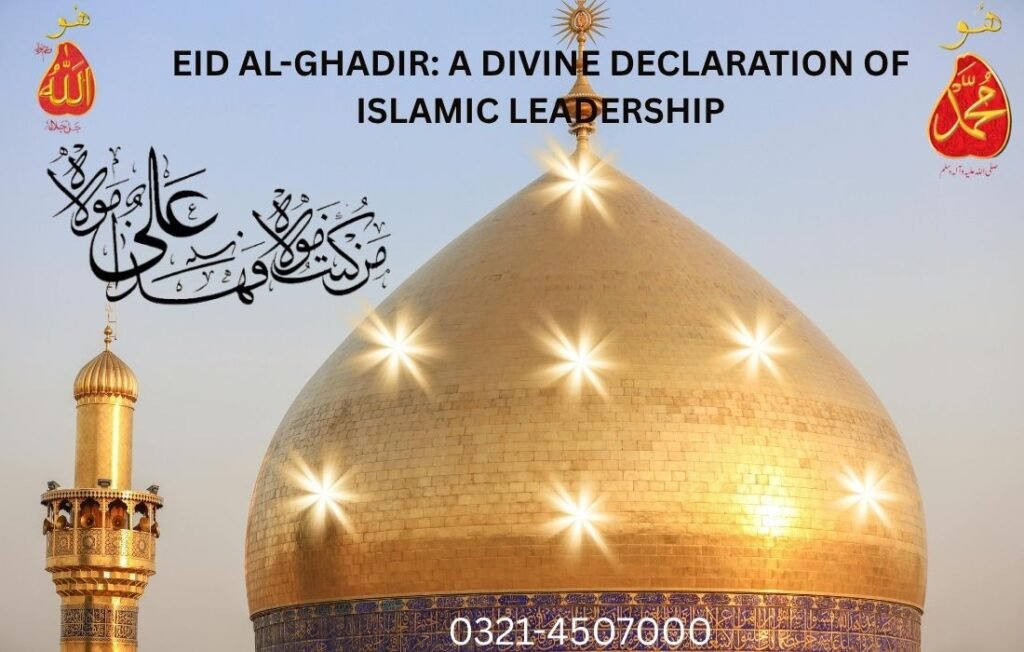Historical Background of Ghadir-e-Khum
In the 10th year of Hijrah, Prophet Muhammad (peace be upon him) performed his first and only pilgrimage, known as the Farewell Pilgrimage (Hajjatul Wida). After completing the rites of Hajj, the Prophet and a massive caravan of more than 100,000 companions began their journey back to Madinah.
On the way, at a place called Ghadir Khum, a divine revelation descended:
“O Messenger! Proclaim what has been sent down to you from your Lord. If you do not, then you have not conveyed His message.”
(Surah Al-Ma’idah: 67)
This verse indicated the importance of a particular message that needed to be publicly delivered. The Prophet (PBUH) ordered the entire caravan to stop under the scorching heat. Makeshift shades were made from camel saddles, and a pulpit was set up for the Prophet to address the gathering.
The Sermon and Declaration
In this monumental sermon, Prophet Muhammad (PBUH) recited praise for Allah, reminded the people of the importance of adhering to the Qur’an and Sunnah, and emphasized unity, piety, and responsibility.
He then posed a crucial question:
“Do I not have more authority over you than your own selves?”
The crowd replied: “Yes, O Messenger of Allah!”
The Prophet then raised the hand of Hazrat Ali (AS) and proclaimed:
“Whoever I am master (Mawla) of, Ali is also his master (Mawla).”
This was not merely a statement of love—it was a spiritual, ethical, and leadership declaration. The Prophet then invoked a powerful dua:
“O Allah! Be a friend to whoever befriends Ali, and an enemy to whoever is his enemy. Support those who support him, and abandon those who abandon him.”
Confirmation from the Qur’an
After this declaration, Allah revealed another verse:
“This day I have perfected your religion for you, completed My favor upon you, and chosen Islam as your religion.”
(Surah Al-Ma’idah: 3)
This confirms that the appointment of Ali (AS) was not a personal gesture but a completion of the religion itself.
Hazrat Ali (AS): The Epitome of Leadership
Hazrat Ali (AS) was raised in the household of the Prophet, was the first male to accept Islam, and became one of the most knowledgeable, brave, and devout companions.
His qualities included:
- Knowledge: The Prophet (PBUH) said, “I am the city of knowledge, and Ali is its gate.”
- Justice: Ali’s judgments were legendary for their fairness and wisdom.
- Piety: He lived a humble, God-conscious life, detached from worldly luxuries.
- Bravery: From Badr to Khaybar, his valor was unmatched.
Hazrat Ali (AS) was not only the fourth caliph of Islam but also a symbol of truth, devotion, and divine love.
Eid al-Ghadir’s Relevance for the Ummah
Eid al-Ghadir teaches the Muslim Ummah that:
- Leadership is part of religion: The Prophet (PBUH) ensured that the community had a guide after him.
- Love for Ahl al-Bayt is essential: Loving Ali (AS) is not a sectarian view—it is part of faith.
- Unity is possible: All Muslims, whether Sunni or Shia, acknowledge the greatness of Ali (AS).
- Truth must be followed, even when it is hard.
This day reminds us that leadership in Islam is not about power, but about service, knowledge, and spiritual purity.
Conclusion: Ghadir is a Message, Not Just an Event
Eid al-Ghadir is more than a historical event—it is a divine message of leadership, responsibility, and love for truth. Through Hazrat Ali (AS), the Prophet (PBUH) gave the Ummah a model of a just, brave, and wise leader.

